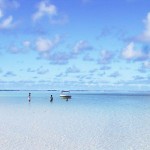The post Moorea appeared first on The Tahiti Traveler.
]]>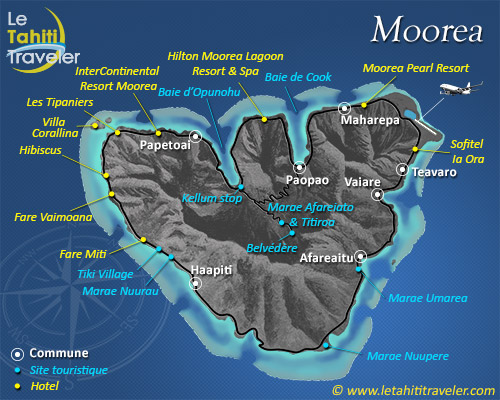 Moorea island with its trident shape and its two famous bays (Cook and Opunohu) was formerly called Aimeho (or Eimeo). It emerged from the water 3 millions years ago. Today, it counts 12,000 inhabitants concentrated in the many villages located seaside – Maharepa, Paopao, Haapiti, Afareaitu (the administrative headquarters) and Vaiare. Its surface is 134 km². The island features 8 mountains (the highest is Mount Tohiea – 1,207 m) and it is only 17 km (10 miles) away from Tahiti. Because of this short distance, Moorea often carries the nickname of “Sister island” (of Tahiti). The name moorea which means the “yellow lizard” would come from a legend where a big yellow lizard would have open the 2 bays with its tail.
Moorea island with its trident shape and its two famous bays (Cook and Opunohu) was formerly called Aimeho (or Eimeo). It emerged from the water 3 millions years ago. Today, it counts 12,000 inhabitants concentrated in the many villages located seaside – Maharepa, Paopao, Haapiti, Afareaitu (the administrative headquarters) and Vaiare. Its surface is 134 km². The island features 8 mountains (the highest is Mount Tohiea – 1,207 m) and it is only 17 km (10 miles) away from Tahiti. Because of this short distance, Moorea often carries the nickname of “Sister island” (of Tahiti). The name moorea which means the “yellow lizard” would come from a legend where a big yellow lizard would have open the 2 bays with its tail.Moorea can be easily visited from Tahiti, either by boat (35 mn) or plane (10 mn). Depending on the ferry company you will select, you will disembark either at Vaiare village that stands at the foot of the mount Mouaputa (830 m) – also called the « Pierced or Sacred mountain » due to its hole situated at its peak, or at the bottom of Cook’s Bay. Strangely enough, Captain Cook did not actually anchored his ship in the bay carrying his name today but in Opunohu’s bay where he remained from September 30th to October 11th, 1777.
Moorea, sometimes described as a huge garden with tropical scents, is covered by trees, carefully maintained gardens, beautiful fare with pandanus roofs, cool rivers and waterfalls. Many beautiful white sand beaches can be found around Temae (near the airport) and Haapiti – the northern coast between Papetoai and Haapiti gathers the most tourists with many hotels and two gorgeous motu (islets) facing Hauru’s point.
Moorea is surrounded by a reef barrier offering 12 different passes among which the pass of Vaiare used by the ferries. Many dolphins can be seen near the Moorea passes and every year, the whales attracted by their natural curiosity come to swim with their babies near the reef (they can be observed from July to October). Moorea lagoon is perfect to practise all kind of nautical activities (snorkelling, diving, jet-ski…). And for those looking for pedestrian or 4×4 excursions, Moorea offers several beautiful and deep valleys.
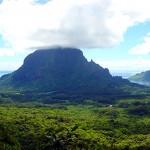
To discover the inner-island, tourists will be able to choose between an island circle tour or a ride over mount Rotui (899 meters). Don’t forget to have a look at the waterfalls of Afareaitu. A visit to Opunohu and Cook Bay is obviously recommended – both bays can be admired from the Belvedere viewpoint.

The many marae spread on Moorea testify the presence of many people in the ancient times. The first European to explore it was James Cook. Wallis had already baptized it “Duke of York island” but he did not take the time to visit it during his 1767 trip. In his 1769 voyage, Cook entered the lagoon through Opunohu’s bay but didn’t visit the island thoroughly.
In 1790, Chief Pomare I (the First) conquered the island of Moorea and left the control of Tahiti to his son Pomare II. However, Pomare II was too young and dictatorial to maintain order and he had to run away from Tahiti and to look for protection in Moorea after the general riots of 1807.
Protestant missioners (from the LMS – London Missionnary Society) settled at Papetoai in 1808 ; a starting point for the evangelisation of the other islands. The octagonal church of Papetoai was built on ancient maraeTaputaputuatea in 1827 – the oldest European building of the South Pacific. It was renovated at the end of the 19th century.
Pomare II, converted to Protestantism, regained his power in 1815 thanks to the missioners. French protectorate was established in 1843.
Meanwhile, the missioners tried to develop textile and cane sugar industries but their efforts remained unsuccessful. In the 20th century, Chinese were hired to take care of the coprah and later in the 70’s, some pineapple plantations were cultivated in Opunohu’s valley. Moorea is today well-known for being the pineapple-growing center of French Polynesia. Don’t forget to taste them at one of the stands along the road or at Vaiare ferry docks prior to departure (around 1,000 xpf for 3-4 pineapples).
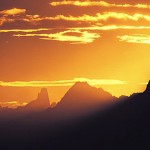
After Tahiti and Bora Bora, Moorea receives the greatest number of visitors, not only tourists but also inhabitants of Tahiti who enjoy spending their weekends and vacations on its white sand beaches.
The post Moorea appeared first on The Tahiti Traveler.
]]>The post Tahiti appeared first on The Tahiti Traveler.
]]>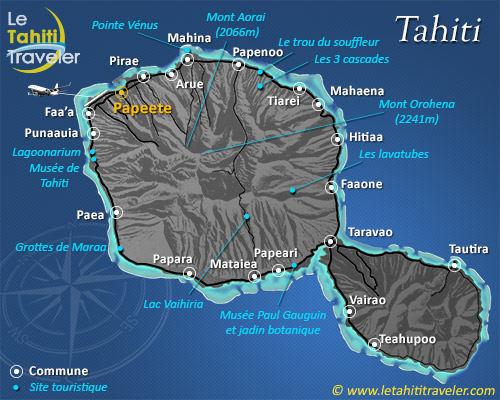
1- Introduction
Tahiti, Otahiti for the first Europeans, the “Island of Love”, the “New Cyther” for Bougainville, the myth of paradise, of Rousseau’s “good savage”, all those names to describe the same beauty of this island, symbol just by itself of the entire French Polynesia.
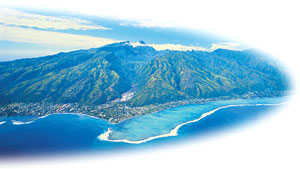
Two volcanos emerged from the waters compose the island of Tahiti : 3-million year old for the Tahiti Nui (the Big Tahiti) volcano, and only 500,000 years for the one of Tahiti Iti (the Little Tahiti) also called the Peninsula (Presqu’ile). Those two extinct volcanoes are joined together by the Taravaoisthmus. Not only one of the most recent island of Polynesia, Tahiti is also the largest (1,045 square kilometres) and the most populated (150,371 persons).
Beware ! Expected white sand beaches bordered by coconut trees and overwater bungalows will be encountered at Bora Bora or in the Tuamotu islands rather than Tahiti. However, Tahiti is full of pleasant surprises for those taking the time to observe it and to discover its secrets…
Circle shape, Tahiti is entirely surrounded by a lagoon except for a north coast part going from Mahina to Tiarei. Its reef barrier is cut by 33 passes, the one of Papeete being the largest. From the Taharaa viewpoint(Mahina), you will overhang the Matavai Bay where the first explorers anchored more than 250 years ago.
Tahiti Nui is dominated by abrupt mountains like Mount Orohena (2,241 m), famous Mount Aorai (2,066m) and Diadem (1,321 m) – names given by Dumont D’Urville – and Mount Marau (1,493 m) cut by deep inhabited and luxuriant valleys. Those valleys – described by French writer Loti – feature numerous waterfalls pouring into refreshing basins which will be highly appreciated by curious visitors. Tahiti also conceal many archaeological sites and mysterious caves.
Tahiti Iti is dominated by Mount Ronui (1,332 m) and Mount Meirenui (1,306 m). Surrounded by a coral reef and a lagoon with white sand beaches, Tahiti Iti is bordered by the “Te Pari” vertical cliffs which are accessible only by boat or by foot (with a guide !) and it offers many treasures such as the “Devil Pass”, the “Giant Umete of Taapeha”, caves, petroglyphs, archaeological sites full of legends, hollow rocks called the “Honoura Drums” … all this taking you over to some enchanting spots at the edge of the world.
Tahiti offers splendid diving excursions, especially in Tahiti Iti, and spectacular basalt black sand beaches around Papara and on the east coast, both spots being suitable for surfing.
 But Tahiti is also the economic heart of French Polynesia. Papeete, its capital, is built along a friendly waterfront (recently renovated) welcoming many shops and luxury ships. It is the unique city at 4,000 kilometres around (!!) and one will find here everything he needs, market (a must), jewellers, bars, nightclubs, restaurants (French, Chinese, Italian…), hospitals…
But Tahiti is also the economic heart of French Polynesia. Papeete, its capital, is built along a friendly waterfront (recently renovated) welcoming many shops and luxury ships. It is the unique city at 4,000 kilometres around (!!) and one will find here everything he needs, market (a must), jewellers, bars, nightclubs, restaurants (French, Chinese, Italian…), hospitals…
2 – Brief history
Tahiti was not the first island to be settled by Polynesians. According to the legend, it would have been populated around 850 AD by people coming from Raiatea, the “Sacred Island”, cradle of the Polynesian civilization.
The supremacy of Tahiti over the other islands came with the first Europeans’ arrival. At that time, the island was divided into 6 large districts ruled by chiefs (ari’i). The Pomare dynasty is issued from the district of “Te Porionuu” (Pare, Arue) and it imposed itself thanks to the assistance of the navigators remaining in Matavai Bay.
On June 17, 1767, English captain Wallis aboard the “Dolphin” ship was the first European to visit Tahiti. He baptized it “King George Island”. The first contacts with the local population were stormy and required Wallis to make use of his cannons. That date changed forever the social balance existing between the 6 ruling clans and it was the beginning of a violent fight cycle that ended only 50 years later in 1815.
One year later (1768), Bougainville also annexed Tahiti, this time for French king Louis XVI. Then cameCaptain Cook whose precious written testimonials largely contributed to Polynesian culture learning.
All those navigators were quickly followed by English missioners of the London Missionary Society (LMS). They first came in 1797 but were first forced back after they tried unsuccessfully for many years to implement Christianity.
In 1815, King Pomare II definitely came to the throne after winning the battle of Narii (from a Punaauia temple holding the same name) or Fei Pi (the Green bananas), thanks to the help of Leeward islands warriors. This last battle was the end of the ancient Polynesian aristocracies ruled by the ari’i and is synonymous to the defeat of paganism versus Christianity. Moreover, the pre-eminence of Tahitian kings who were already dominating the Tuamotu islands was slowly accepted by a growing number of islands like Tubuai and Rimatara.
Following Pomare II request, a 19-law code baptized “Pomare Code” was established and approved in 1819. It was inspired by puritan concepts of the English missioners and tried to put an end to old customs such as human sacrifice, infanticide and licentious behaviours.
In the middle of the 19th century, Moerenhout, American then French Consul, first asked Queen Victoria to take control over the island in order to maintain order but she refused. So he asked the French …
On September 9, 1842, a convention establishing a French Protectorate is signed between Queen Pomare IV, the regent Paraita and French admiral Dupetit-Thouars. But this status became effective only 5 years later in 1847. Indeed in 1843, Pomare IV who was under the influence of Pritchard, English Consul, denounced the treaty.
On November 1, 1843, Dupetit-Thouars reacted : the queen was overthrown, the annexation of Tahiti was proclaimed and French troops invaded the island. The franco-tahitian war began at Taravao on March 21, 1844 and ended on December 18, 1846.
On June 29, 1880, King Pomare V gave definitely all his territories to France. The French protectorate became the Etablissements Français d’Oceanie (E.F.O.) – French Establishments of Oceania – with its capital Papeete. The transfer to France of the Tahitian kingdom (Society Islands, Tubuai Islands and the Tuamotu) was ratified by the Law of December 30, 1880 that gave the French citizenship to all King Pomare subjects.
The Law of July 26, 1956, transformed the E.F.O. into French Polynesia, giving a more effective autonomy to the territory.
Tahiti has been most concerned by economic and social developments of the 60’s (construction of Faa’a International Airport, development of the Papeete harbour, evolution of the urban landscape). This development generated strong migrations towards Tahiti that gathers today 70% of the total population of French Polynesia.
Although the government is trying to inverse that trend by focusing on the development of activities in other islands, Tahiti remains today the economic, political, administrative, social and cultural center of French Polynesia.
Source :
– History of Tahiti, by Ph. Rey Lescure
– Le mariage franco-tahitien, by Pierre-YvesTOULLELAN & Bernard GILLE
– Presidency website ( www.presidence.pf )
The post Tahiti appeared first on The Tahiti Traveler.
]]>